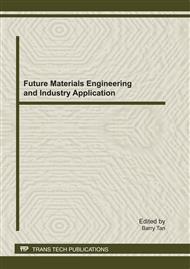p.320
p.326
p.332
p.338
p.342
p.348
p.354
p.361
p.367
Properties of Arabinoxylans from Wheat Bran, Shorts and Flour
Abstract:
Arabinoxylans were prepared from bran, shorts and flour, three wheat milling fractions. The yields of bran arabinoxylan (WBAX), shorts arabinoxylan ( WSAX) and flour arabinoxylan ( WFAX) were 8.99%, 7.28% and 1.12% respectively. Sugar composition analysis showed that WFAX contained less non-cellulosic sugars ( 75.56%) compared with WFAX and WSAX. WBAX had the lowest Ara/Xyl ratio compared with WSAX and WFAX. HPSEC analysis showed that WFAX had higher molecular weight compared with WBAX and WSAX, and WBAX had the lowest molecular weight. WBAX, WSAX and WFAX in water solution had higher molecular weight than in 0.5mol/L NaOH and 1.0mol/L NaOH. In 1.0 mol/L NaOH solution, arabinoxylans had the lowest molecular weight compared that in 0.5 mol/L NaOH and distilled water. From the recovery of WBAX, WSAX and WFAX in different solvents, it showed that 1.0N NaOH had good dissolved effect for arabinoxylans, and water heating treatment ( 80°C 2hr, then stirring overnight at room temperature) had poor dissolved properties compared with 0.5 mol/L NaOH and 1.0 mol/L NaOH ( 25°C,2hr)
Info:
Periodical:
Pages:
342-347
Citation:
Online since:
October 2011
Authors:
Keywords:
Price:
Сopyright:
© 2012 Trans Tech Publications Ltd. All Rights Reserved
Share:
Citation:


